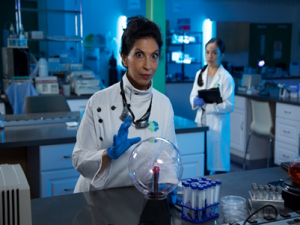Frankenstein Outside the Castle
Posted on Categories Discover Magazine

It’s alive! The first time Mary Shelley introduced Dr. Frankenstein’s lab in her 1818 novel, she described it as “a solitary chamber, or rather cell, at the top of the house… I kept my workshop of filthy creation… The dissecting room and the slaughter-house furnished many of my materials.” Two hundred years later, researchers at Arizona State University (ASU) in Tempe, Arizona are challenging that origin story with a sleek, modern Frankenstein lab. Thanks in part to a grant from the National Science Foundation, the Center for Science and Imagination has brought Frankenstein back to life. This new creature is Frankenstein200: an interactive story-telling experience, allowing players to begin answering Mary Shelley’s timeless questions about life and ethics. Frankenstein200 is rated by the researchers as PG and is targeted to players ages 10-14, though all ages can enjoy.

Students creating Scribblebots, one of the projects incorporated into the narrative | Image courtesy of ASU
The original digital narrative begins in Dr. Victoria Frankenstein’s laboratory. The Laboratory for Innovation and Fantastical Exploration (L.I.F.E) looks like many other modern labs—stark white walls, stainless steel tables, and and a collection of research tools. The young researchers Mya and Xavier are pursuing an understanding of gene editing and artificial intelligence and ask the players (users who register online) for moral and ethical input. As players proceed through the story, they also engage in at-home maker activities, online challenges, and design competitions involving hands-on science and other creative tasks. Though the digital platform designed for a single-player, you can also participate in related group activities at one of the partner institutions. Museums, science centers, and other learning hubs can use tabletop kits provided by the program as a complement to the online experience.
Once players sign up, they follow a story that unfolds in real time, receiving emails about new events. The main thread of the story centers on Dr. Victoria Frankenstein’s quest to clear the Frankenstein name with her research mission. Just as Dr. Frankenstein’s biological research pulls in global influences, the online platform relaying her story also seeks a far reach. Bob Beard, the ASU project manager, praised the Frankenstein theme as integral to this outreach, saying that it allows the project to reach a wider audience. “Because of its popularity across mediums and around the world, everyone understands Frankenstein.”
The Workshop has downloadable, do-it-yourself at home activities available to everyone, whether or not you sign up for the game. Everyone who completes a Workshop activity and submits a picture of what they made will get a personalized commemorative certificate, similar to the one below.
Now—with museum partners, resources for educators, and the online portal—people from all over the world can go even deeper into the story and also shape a new version of Frankenstein and cutting edge research in the 21st century. According to the website, players of Frankenstein200 seek to understand life, what it means to be human, and why we create. These questions matter when we look forward to the future of artificial intelligence, robotics, and genetic engineering.
Start redefining Frankenstein today.
Want more citizen science? Check out SciStarter’s Project Finder! With 1100+ citizen science projects spanning every field of research, task and age group, there’s something for everyone!
 Katherine Ball is a Master of Science and Technology Policy student at Arizona State University. Her work focuses on public engagement with environmental policy—primarily how communities mobilize including citizen science. Katherine also acts as coordinator of the ASU Citizen Science Network, working to connect and empower citizen science projects around Arizona. She can be found on Twitter @lonlygnome.
Katherine Ball is a Master of Science and Technology Policy student at Arizona State University. Her work focuses on public engagement with environmental policy—primarily how communities mobilize including citizen science. Katherine also acts as coordinator of the ASU Citizen Science Network, working to connect and empower citizen science projects around Arizona. She can be found on Twitter @lonlygnome.
